EV Ownership 101
Are you considering buying an EV and wondering what it will be like to own and drive? Or, perhaps you have already taken the plunge and now you are looking for some help figuring out some of the basics.
Either way, this section is for you! We’ll walk you through the basic steps for charging, maintaining and driving your EV throughout the year.
Vehicle Types
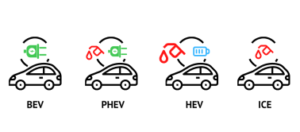
We focus on BEVs but PHEV owners may find some of the information helpful.
BEV – Battery electric vehicle. Uses electricity only.
PHEV – Plug-in hybrid electric vehicle. Uses electricity and gasoline.
HEV – Hybrid electric vehicle. Uses gasoline only, but has a small battery and electric motor to improve efficiency.
ICE vehicle – Internal combustion engine vehicle. In 2022, most vehicles on the road fall into this category. Uses gasoline/diesel exclusively.
What's It Like to be a New EV Owner?
Ride along with Gail Walker as she shares her experience in this video.
Charging Levels/Speeds
Level 1
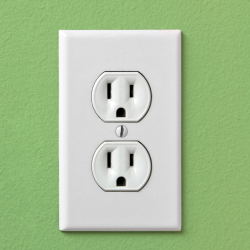
This refers to charging from a regular household 120 Volt outlet. All EVs come with a kit, also referred to as a mobile charger, which allows you to do this. This is the slowest charging method but even so, many EV drivers find an overnight charge at Level 1 is more than enough for a typical day’s driving. Maximum charging power is 15 Amps x 80% x 120 Volts = 1.4 kW. Depending on current battery charge and temperature, a 10-hour overnight charge could add over 75 km of range.
Level 2 or Tesla Destination


Level 2 chargers all require 240 Volt power, similar to an electric oven or dryer. These chargers are installed at home and at commercial locations such as stores and hotels. These chargers have either a J1772 plug or a Tesla plug. The most common is the J1772 plug. Adapters are available to allow Teslas to use J1772 plugs and non-Teslas to use a Tesla plug. Maximum charging power varies from about 7 kW to 11 kW or more. Depending on current battery charge and temperature, a 5-hour charge at 7 kW could add over 190 km of range.
DCFC (direct current fast charging)
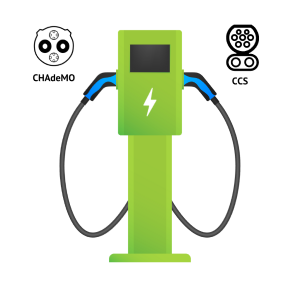
DCFC chargers are used when you want or need to minimize the time spent charging. That typically happens when your road trip is longer than one charge will take you. The fees for this charging are higher for this convenience. There are two types of plugs for DCFC charging: CCS and CHAdeMO. All EVs can use one or the other although Teslas need an adapter. Maximum charging power is at least 50 kW but often exceeds 150 kW. Actual charging power/speed depends on current battery charge and temperature.
Supercharging
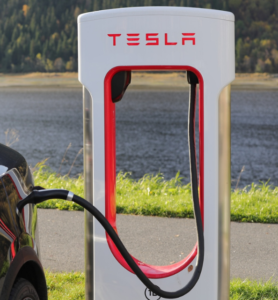
Superchargers are really just Tesla’s proprietary version of DCFC chargers. In North America, these only have Tesla plugs. Depending on the specific installation, maximum charging power is up to 72, 150, 250 kW. Actual charging power/speed depends on the battery state of charge, temperature and maximum power supported by the EV.
Conditions Affecting Charging Speed

In addition to the capability of the charger and the EV, charging speed depends on the current charge level of the battery and the battery temperature. As a general rule a battery which is hot or cold or close to fully charged or almost fully discharged will charge slower than a warm battery with a partial charge. If you always charge at home, you may never notice this effect. When using a fast (DCFC) charger, such as you would on a road trip, this effect becomes very noticeable. As a guideline, it tends to be faster and cheaper to plan to charge from 10-20% to 80-90% at each stop.
Charging at Home (Level 1 or 2)
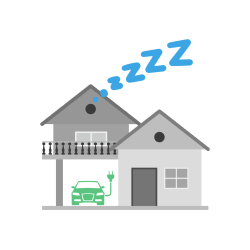
One of the best benefits of an EV is that it can be conveniently and cheaply charged overnight at home. Most EV owners do most of their charging at home where it’s cheap and convenient. You can install a wall mounted charger or simply plug your EV into a regular (120v) or 240v wall outlet. Typically, an EV driver arrives at home at the end of the day, plugs in their EV and doesn’t think about it again until it’s time to leave in the morning. All EVs come with the ability to schedule charging for off-peak times. That allows you to automatically reduce the peak load on your local power utility and reduce your power costs in areas with off-peak rates.
EV batteries are designed to last 10-15 years or more. For many EVs you can ensure you get the most life out of your battery by keeping the charge level between 20% and 80%. This is easy to do by using the charge scheduling features built into your EV to finish charging to 80% just prior to your departure each day.
When you do fully or almost fully charge your EV then it is best to minimize the amount of time that the battery sits at a high charge level by driving soon afterwards. 80% is considered a conservative guideline, not a rule, so don’t worry about bending it. In fact, for some EVs this guideline is unnecessary but following it will never hurt. Check with your manufacturer/dealer.
Using Public Charges (Level 1 or 2 or DCFC)
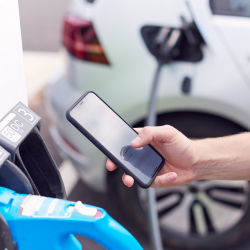
Most public chargers are set up in networks provided by companies that require that you set up an account with them in advance. A few examples include eCharge, FLO, ChargePoint, Circuit Electrique, and Tesla but there are many more. Some public chargers are free to use, some require a special condition (e.g. you need to be a customer of the business that owns it), and some will accept a credit card at the charger station (e.g. Petro-Canada charging stations).
To decide which network(s) would be best for you, find out which has chargers in areas you are likely to travel to or through. The best facility for finding chargers is the website plugshare.com.
Once you’ve created an account the charger network will issue you a card and/or provide a smart phone app either of which can be used to activate charging. One last thing, you’ll need to use your credit card to add funds to the account which are reduced each time you charge. The only exception to that rule is Tesla which automatically dings your credit card each time you use a Tesla supercharger.
Public Charging Etiquette

Occasionally, you may find that a public charger has been blocked by an ICE vehicle parking in a “EV Charging Only” spot. The common phrase for that is “the charger has been ICE’d.”
Many ICE drivers are unfamiliar with the importance of leaving access to chargers open for EVs. Although being unable to access a charger can be frustrating, it is good etiquette and most effective, to choose to do education rather than complain. If the driver is present then ask them to move and explain why. If not, leave a note with an explanation. You could draw a comparison to blocking access to a gas pump. Often, people are simply not thinking in those terms. Our goal as early EV adopters is to gain awareness and understanding.
Also, don’t forget the “Charging Only” part of “EV Charging Only”. If you don’t need to charge or have finished charging then move your EV so the charger is available for others.
Please help the EV community by checking in on PlugShare.com when you charge. This is helpful for many reasons:
- EV drivers looking for a charge can tell at a glance which chargers are already in use.
- If you have problems using a charger you can indicate that on plugshare.com which will warn other EV drivers.
- Chargers can break down or have intermittent issues so seeing that a charger has had lots of recent successful check-in’s can be very reassuring.
- Adding a comment or photo to the charging station on plugshare.com can help the next driver find and use the station especially if it has any special quirks.
Road Trips
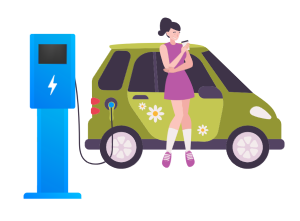
Road trips do require a little preparation.
- Plan your charging stops in advance. PlugShare.com and aBetterRoutePlanner.com are both excellent sources of charger location and availability. If you expect wet or snowy roads or a strong head wind then expect to use more energy between chargers.
- To reduce charging costs, book your overnight stays at places with chargers or at least an available 120 volt outlet.
- Preheat (precool) your EV before unplugging. Once the cabin has been heated it takes much less energy to keep it heated. Also, note that using heated seats to help stay warm uses far less power than heating the cabin.
- For safety and the best range, check your tire pressure for the recommended level.
- When you are on the highway and you notice that the charge level is going down faster than you expected then here are a few things to try:
- Slow down. Even driving 5 km/h slower makes a significant difference at any speed above 90 km/h.
- Reduce the amount of cabin heating. Use your heated seats more/instead.
- Check to see if there is a closer charger. Even a level 2 charger should be able to quickly add enough charge to get you to the next fast charger.
Running Out of Charge
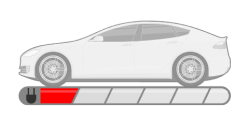
Uh-oh. All that careful planning but you still ended up on the side of the road with not enough charge to get you to your designation. Here are some things you can do to help get you to the next charger. It’s best to always keep your mobile charger in the EV, just in case.
- Check your EV’s navigation system or plugshare.com to see if there is a charger nearby. Be sure to check for level 1, level 2 or level 3 or even a publicly available outlet. Chargers are continuously being added so one may be closer than you think.
- When you realize that you are not going to make it to the next charger try stopping at a business and ask if you could plug into an (120v) outlet for a while.
- If you have a roadside assistance service, such as CAA, then ask if they can provide roadside charging.
- If all else fails then get your EV carried on a flatbed tow-truck to the nearest charger.
Winter Driving
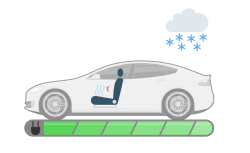
Freezing temperatures both lower battery performance and increase power demands due to the need to heat the passenger cabin. You may experience a 10-30% decrease in range depending on weather conditions, EV model and driver experience. See the section on range for tips on reducing the effect of cold weather on range.
When an EV is parked in the cold (especially below zero Celsius) it will use battery power to keep the battery itself from getting too cold. That means, if you do need to park in cold weather for an extended period, e.g. days, then it’s a good idea to keep your EV plugged in.
An EV battery is heavy and located at the bottom of the car. This tends to improve traction and stability but it’s always a good idea to install good quality winter tires for the snowy season.
Learn about how frigid conditions affect a Tesla Model S. You’ll be pleasantly surprised.
Regenerative (regen) Braking
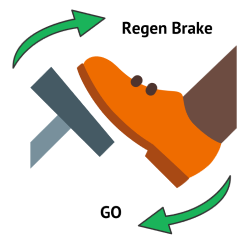
Regenerative or regen braking uses the motor to slow down the EV and uses the energy to charge the battery. It saves power, extends range, and reduces wear of mechanical brakes.
Regen braking is automatically activated when you reduce the pressure on the accelerator pedal. Some EVs also provide a stalk or paddle on the steering wheel column to activate regen braking. Just like in an ICE vehicle, reducing pressure on the accelerator pedal slows you down. The difference with an EV is that you’ll notice that the same action has more effect. People call it “one pedal driving” because you can both speed up or slow down to a stop simply by adjusting how much you press on the accelerator pedal. Of course, the brake pedal is still there if you need to brake more quickly.
Maintenance

EVs have very little maintenance compared to an ICE vehicle. No oil changes or annual tune-ups! No exhaust system to fix or spark plugs to replace. To identify the few things you do need, check the manual for your EV. You may need to use the manual to convince shops inexperienced with EVs that you don’t need any more.
One thing in particular to keep in mind is the hydraulic braking system. Thanks to regenerative braking, that system doesn’t tend to work very hard. That can cause the abundance of salt and sand on winter roads to creep into your brakes, reducing your range. To avoid a loss in range and unnecessary brake wear, be sure to have the brakes cleaned and lubricated each spring when you take off your winter tires.
Home Charger Installation

One of the best benefits of an EV is that it can be conveniently and cheaply charged overnight at home. While a regular plug may be sufficient, many EV owners install a wall mounted level 2 charger for flexibility. The setup of a charger involves installing a circuit similar in power to that used for an electric oven. Mount your charger inside your garage or outside as close to your parking area as possible. Charger models range from basic to Internet-based features. Some models may be eligible for rebates in your area. Check before buying.
EVs draw a lot of power so for any electrical work it is best to hire an electrician to ensure the installation is safe and reliable.
Support
Do you still have questions? No problem! Many EV owners are very happy to help out by answering questions, walking you through your first public charge, etc. Just ask. Here are just some of the many EV groups across Canada:
Other EV Stuff
Camping with EVs
Electric cars have some unique characteristics that make them ideal camping companions. Here’s one experience.
NissanConnect Setup Guide
EV Society Kawartha Chapter member, Jake Branch, has written this easy step-by-step setup guide for NissanConnect.
Measure Your Carbon Footprint
Use the tool at CarbonFootprint.com to understand your own emissions and how to help reduce them. Includes Ontario-level data.
EV Conversions
If you are interested in EV conversion information you can access detailed information from our archived historical site.
Buying an EV
Which cars qualify for the government rebate?
Only vehicles below a certain value qualify for the federal government rebate. Find out which on this government website. Some provinces and municipalities offer additional incentives, but currently that is not the case in Ontario.
How many EVs are sold in Canada?
Excellent data on the sales of electric vehicles in Canada has been complied by Matthew Klippenstein for Green Car Reports and can be viewed HERE
Statistics Canada has current charts for all vehicles by fuel type HERE
Toggle the BEV, HEV, and/or PHEV buttons to see different combinations of battery electric, hybrid electric and/or plug-in hybrid electric vehicles sold.
Think you can't afford an EV?
Think you can’t afford an EV? In a faceoff against gas cars, the numbers say otherwise.
Electric Motorcycles
The quality and capabilities of electric motorcycles are accelerating at the same pace as their car counterparts. It’s an exciting and fuel-efficient time to think about going electric on two wheels!
Global EV Sales Targets and Policies
The EV Society compiled a comprehensive comparison of electric vehicle targets from auto manufacturers and policy makers around the world.
EV Specifications (2017)
How much range does a Chevy Bolt have? What does a BMW i3 cost? What cars have DC Fast Charging?
To Compare All 2017 EV and PHEV vehicles Click Here
Owner Experience
Click below to watch, listen and read firsthand experiences of those who’ve already made the switch to electric vehicles.
Search
Looking for something in particular?
Recent Posts
The economics and adoption wave of pure electric vehicles – don’t get swamped!
Electric vehicles are continuing to march along the ‘S’ curve of adoption toward inevitably replacing the internal combustion engine. Why inevitably? Because they are simply superior in every aspect except price, and that drawback too is also disappearing quickly. Soon, they will be better in all respects.
CBC – The National: EV Series
CBC News - The National has featured electric vehicles before. Last year they went on an EV road trip from Toronto to Detroit. In this trip, however, a few things went wrong and did not show the true advantages of driving electric. This year they are back with the...
Looking Back on Today
By Peter Vella The year is 2039. A twelve year old boy is sitting down with his grandfather to work on an essay that the boy is preparing for his grade six history module. “So Grandpa Liam, I need you to help me. I think you were alive when the thing I have to write...
“I rode an electric motorcycle 1,000km for a cost of about $8”
By Spencer Wright Spencer Wright chose an electric motorcycle for his commuter vehicle and quickly racked up 9,000km. In 2015, I bought my 2013 Zero S as a stepping stone into the EV world. There were no fully electric cars on the market that both fit my range needs,...
Electric Vehicle Charging Etiquette
To create a happy public charging experience for all, EV Society encourages drivers to abide by these etiquette recommendations. If you drive a gas or diesel Internal Combustion Engine (ICE) vehicle, please do not park in a spot designated for an EV no matter how...
Want more knowledge?
EV Society is a non-profit organization passionate about bringing change in the way we drive. EVs are cleaner, quieter, faster, and cheaper than their fossil-fuel-powered counterparts. Become a member to enjoy a number of perks and to engage with our experienced and knowledgeable members.